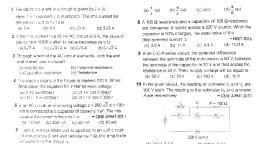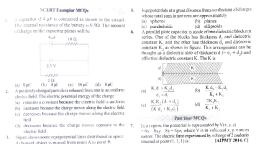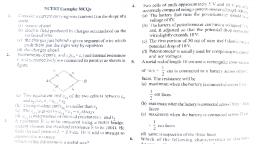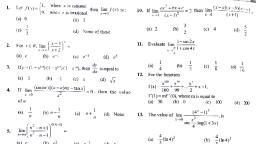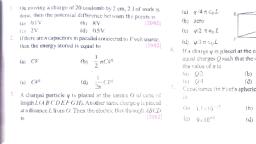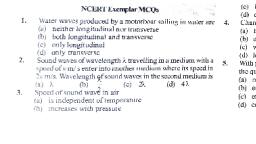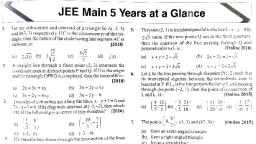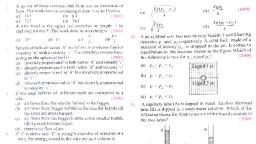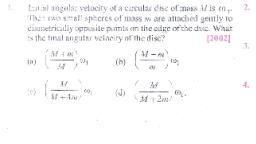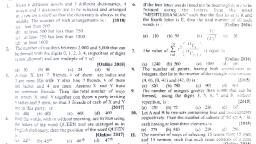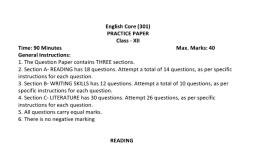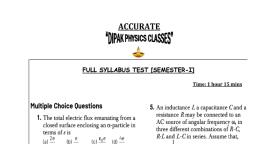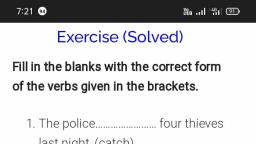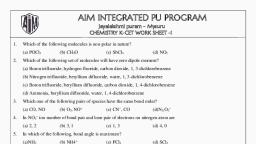Question 1 :
The 90 pF capacitor is connected to a 12 V battery. How many electrons are transferred from one plate to another?
Question 2 :
A parallel plate capacitor is charged an then disconnected from the charging battery. If the plates are now moved farther apart by pulling at them by means of insulating handles, then
Question 5 :
When a positive <img style='object-fit:contain' width=8 height=20 src="https://storage.googleapis.com/teachmint/question_assets/NEET/5ea1838a1ac76a0b860fd4b7"> charge is taken from lower potential to a higher potential point, then its potential energy will
Question 6 :
In the above problem, minimum work is done when the body is
Question 7 :
The work done in moving an object from origin to a point whose position vector is $\overline{r}=3\hat{i}+2\hat{j}-5\hat{k}$; by a force $\overline{F}=2\hat{i}-\hat{j}-\hat{k}$ is :<br/>
Question 8 :
Mass {tex} m _ { 1 } {/tex} strikes {tex} m _ { 2 } {/tex} which is at rest. The ratio of masses for which they will collide again (collision between ball and wall are elastic, coefficient of restitution between {tex} m _ { 1 } {/tex} and {tex} m _ { 2 } {/tex} is {tex} e {/tex} and all the surfaces are smooth.)<br><img style='object-fit:contain' src="https://storage.googleapis.com/teachmint/question_assets/NEET/5e0ee807dc973f528b538d7a"><br>
Question 9 :
A rope is used to lower vertically a block of mass M at a distance x at a constant downward acceleration $g/2$. The work done by the rope on the block is:
Question 10 :
A force of $ 2\hat { i } +3\hat { j } +2kN $ acts on a body for 4 s and produces a displacement of $3\hat {i} +4\hat {j} +5 \hat {k} m $ calculate the power ?
Question 11 :
Two particles, each of mass {tex} 2 \mathrm { kg } {/tex} are put at {tex} ( 2 \mathrm { m } , 0 ) {/tex} and {tex} ( 0,2 \mathrm { m } ) , {/tex} as shown in figure. Now {tex} 1 \mathrm { kg } {/tex} mass of particle {tex} \mathrm { A } {/tex} is put on to the particle {tex} \mathrm { B } {/tex}. The change in {tex} x {/tex} -coordinate of centre of mass of the system is<br><img style='object-fit:contain' src="https://storage.googleapis.com/teachmint/question_assets/NEET/5e0f0d19ed6e36502132f305"><br>
Question 12 :
(1) Centre of gravity (C. G.) of a body is the point at which the weight of the body acts </p> (2) Centre of mass coincides with the centre of gravity if the earth is assumed to have infinitely large radius </p> (3) To evaluate the gravitational field intensity due to any body at an external point, the centre mass of the body can be considered to be concentrated at its C.G. </p> (4) The radius of gyration of any body rotating about an axis is the length of the perpendicular dropped from the C.G. of the body to the axis </p> Which one of the following pairs of statements is correct
Question 13 :
A thin uniform rod of length {tex} l {/tex} and mass {tex} m {/tex} is swinging freely about a horizontal axis passing through its end. Its maximum<br>angular speed is {tex} \omega . {/tex} Its centre of mass rises to a maximum height of<br>
Question 14 :
A metal sheet {tex} 14 \mathrm { cm } \times 2 \mathrm { cm } {/tex} of uniform thickness is cut into two pieces of width {tex} 2 \mathrm { cm } . {/tex} The two pieces are joined and laid along {tex} X Y {/tex} plane as shown. The centre of mass has the coordinates<br><img style='object-fit:contain' src="https://storage.googleapis.com/teachmint/question_assets/NEET/5e0f0cb2ed6e36502132f2bd"><br>
Question 15 :
A rolling body is kept on a plank {tex} \mathrm B{/tex}. There is sufficient friction between {tex} \mathrm A{/tex} and {tex} \mathrm B{/tex} and no friction between {tex} \mathrm B{/tex} and the inclined plane. Then body:<br><img style='object-fit:contain' src="https://storage.googleapis.com/teachmint/question_assets/NEET/5e0f0fd04faa335027dc7821"><br>
Question 16 :
A cloud is at a potential of $8\times 10^{9}\ V$ relative to the ground. A charge of $40\ C$ is transferred in a lightning stroke between the cloud and the earth. The energy released is:
Question 17 :
If a charge is moving along the direction of coulomb's force of an electric field,
Question 18 :
The potential at a point due to a charge of $5\times { 10 }^{ -7 }C$ located $10cm$ away is  $4.5\times { 10 }^{ 4 }V$. The work done in bringing a charge of $4\times { 10 }^{ -9 }C$ from infinity to that point is:
Question 19 :
In coolidge tube the potential difference between cathode and anticathode is $120kV$. The maximum energy of emitted X-rays will be :-
Question 20 :
If a positive charge is shifted from a low potential region to a high potential region, the electric potential energy:
Question 21 :
A cable carrying a direct current is burried in a wall which stands in a north-south plane. A horizontal compass needle on the west side of the wall is found to point towards south instead of north. The coil is laid
Question 22 :
A uniform electric field and a uniform magnetic field exist in a region in the same direction. An electron is projected with a velocity pointed in the same direction. Then the electron will
Question 24 :
Alpha particles {tex} \left( \mathrm { m } = 6.7 \times 10 ^ { - 27 } \mathrm { kg } , \mathrm { q } = + 2 \mathrm { e } \right) {/tex} are accelerated from rest through a potential difference of 6.7 {tex} \mathrm { kV } {/tex}. Then, they enter a magnetic field {tex} \mathrm { B } = 0.2 \mathrm { T } {/tex} perpendicular to them direction of their motion. The radius of the path described by them is
Question 25 :
A short magnet oscillates in an oscillation magnetometer with a time period of 0.10{tex} \mathrm { s } {/tex} where the earth's horizontal magnetic field is 24{tex} \mu T {/tex} . A downward current of 18{tex} \mathrm { A } {/tex} is established in a vertical wire placed 20{tex} \mathrm { cm } {/tex} east of the magnet. Find the new time period.
Question 26 :
Interference was observed in interference chamber when air was present, now the chamber is evacuated and if the same light is used, a careful observer will see
Question 27 :
A parallel beam of fast moving electrons is incident normally on a narrow slit. A screen is placed at a large distance from the slit. If the speed of the electrons is increased, which of the following statement is correct?
Question 29 :
Consider the following statements <img style='object-fit:contain' width=9 height=20 src="https://storage.googleapis.com/teachmint/question_assets/NEET/5ea297208ab67a08eba55c8d"> and <img style='object-fit:contain' width=10 height=20 src="https://storage.googleapis.com/teachmint/question_assets/NEET/5ea297a701a30b5955496f96"> and identify the correct answer<br> A. Polarised light can be used to study the helical surface of nucleic acids<br> B. Optics axis is a direction and not any particular line in the crystal
Question 30 :
The sun is rotating about its own axis. The spectral lines emitted from the two ends of its equator, for an observer on the earth, will show

